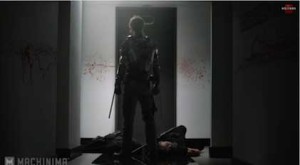 Set in the year 2027, the sci-fi adventure Human Revolution – Deus Ex, which recently launched on Machinima.com’s Machinima Prime channel, imagines a dystopian society in which multinational corporations are larger than national governments and one man – equal parts human and machine – is determined to destroy the system. Director/writer/actor Moe Charif turned to sound design/audio house HOBO to craft an audio landscape as intricate and immersive as the visual one he created.
Set in the year 2027, the sci-fi adventure Human Revolution – Deus Ex, which recently launched on Machinima.com’s Machinima Prime channel, imagines a dystopian society in which multinational corporations are larger than national governments and one man – equal parts human and machine – is determined to destroy the system. Director/writer/actor Moe Charif turned to sound design/audio house HOBO to craft an audio landscape as intricate and immersive as the visual one he created.
“When I saw the rough cut of Moe’s initial trailer, I knew this was something we were going to be proud of,” said Howard Bowler, HOBO’s president. “It looked incredible, and this film gives us the opportunity to put our sound design capabilities toward something totally different. Moe’s action sequences were extremely well thought out visually and we were gratified that he was open to some experimentation sonically.”
Featuring sound design and audio mix from HOBO’s Diego Jimenez, Human Revolution is based on the videogame of the same name. The 13-minute film focuses on Adam Jensen (played by Charif), a security manager at a biotechnology firm who was mortally wounded in a terrorist attack and forced to undergo radical life-saving surgeries, replacing parts of his body with robotic prostheses. Jensen has to work quickly to save the life of ex-girlfriend Megan Reed, a top scientist at the company.
“The visuals inspired me,” Jimenez said. “Moe had worked with a few different sound designers and just wasn’t satisfied. He wanted to experiment differently with the audio. So we ended up recording and sampling some raw sounds at extremely high sample rates, like clanging metal and sandpaper, and then drastically altering it digitally. For us, it’s always about the cinematic experience for the viewers. Good sound enhances that experience. Each step in the process we would ask ourselves, ‘What do we want the viewers to feel now?’”
Jimenez explained that because the film was shot in multiple interior locations it was difficult challenging to match the production sound so that it all sounded consistent. Every scene required an intensive amount of sonic elements to create the futuristic ambiance essential to the film.
For Charif, who first worked with HOBO and Jimenez on the film’s trailer before bringing them the entire film project, working with a sound designer who could pick up on the subtle tonal shifts was essential.
“I always say that sound can make or break a film, and that’s especially true of this project,” said Charif. “When I work with good artists, I always give them the freedom to be creative, and we experimented a bit until we got something that worked. I was looking for a specific sound that depicted the robotic and electronic nature of the characters while sounding cool and realistic. I’m very happy with the end result.”





